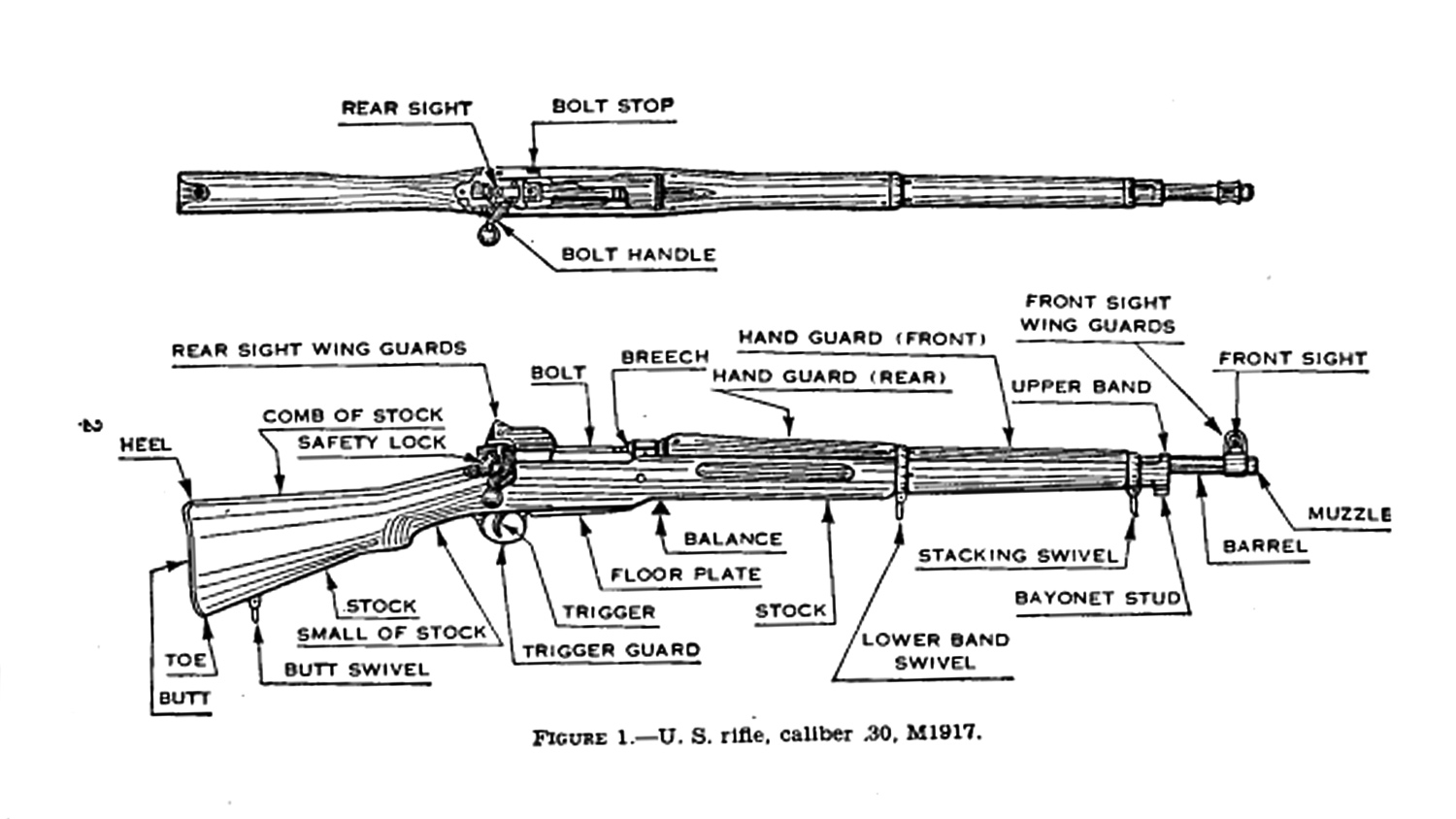
Above: Competitors equipped with 1917 Enfield rifles were successful at the 1918 National Matches, such as Marine Sgt. H.J. Hoffner, who used one to win the President’s Match that year.
Ben Comfort, who won the 1935 Wimbledon Cup using a custom-built Model 1917, U.S. military rifle, was not the first shooter to shoot an “American Enfield” at Camp Perry, not by a long shot. That first occurred in 1918.
The Small Arms Firing School (SAFS), in 1918, was different from the school as it operates today. In 1918, the SAFS trained personnel to act as rifle marksmanship instructors. The course lasted a month, with a new class beginning every two weeks. Most students were military officers learning how to run a marksmanship program and conduct range operations as well as learning how to shoot and how to teach the fundamentals of marksmanship. Classes numbered 500, more or less.
Over and above the regular schedule of classes, a special 10-day SAFS session was held at Camp Perry. This special class was attended by 54 16-person teams—representing 36 of the then-current 48 states and the District of Columbia; the Arkansas National Guard, the Army (2), Navy (2), Marines (2), and the Navy Rifle Range Service (10). In addition, 400 Reserve Officer Training Corps (ROTC) students attended, representing various U.S. colleges and universities. Instead of Springfields, most of the students in this special class drew Model 1917 U.S. Enfields and reported directly from graduation to the range, where they participated in the NRA National Championships, and the National Trophy Individual and Team Rifle matches. The ROTC students were divided into four groups and issued Model 1917 rifles, Model 1903 rifles fitted with one of two types of experimental sights, or standard issue Model 1903 rifles as a control. As an extra bonus, the ROTC students were entered in a special match—20 shots prone slow fire at 500 yards range—the first prize for which was a Winchester rifle. Cadet Edward Parkhouse, of Tulane University, won the Winchester with a score of 97 on the 100-point course. Parkhouse used a Model 1903 rifle fitted with a Warner experimental sight (a modification of the military rear sight that had dial-in changes for major range increments from 200 out to 600 yards plus a standard elevation drift slide for longer ranges).
Shooters’ reaction to the Model 1917 rifles began as “cool,” but warmed up as shooters began to learn the rifle. The chief objections were to the rifle’s “cock-on-closing” bolt and to the lack of a windage adjustment on the rifle’s rear sight. The former was a matter of familiarity. Since the adoption of the Krag-Jorgensen in 1892, American military rifle shooters had a rifle that cocked the firing mechanism as the bolt handle was lifted to unlock the action. British designers of the precursor to the Model 1917 rifle elected to use a mechanism that cocked as the bolt was pushed forward to chamber a cartridge and close the action. Either system had its strong and weak points. The advantages of a cock-on-closing mechanism do not begin to become obvious until firing a rapid fire string. And, in the rapid fire matches, Enfields won unreserved praise.

The sights were another matter, though, and caused something of a division among the student marksmen. Shooters generally from east of the Mississippi River (and presumably familiar with the windage adjustable sights of the Krag and the Springfield) denounced the lack of a windage adjustment on the 1917 rear sight and had trouble holding off, or “favoring” to compensate for changes in the wind. Shooters from out West (and presumably familiar with the non-adjustable sights found on Winchester and other sporting rifles) had little difficulty adapting to the generally excellent aperture rear sight used on the Enfield. They simply applied what is generally referred to as “Kentucky windage” and fired away accurately and effectively.
What about results? We already know that the winner of the special match for ROTC students used a Model 1903 rifle albeit one fitted with experimental sights. Again, one must presume that he was able to compensate for changing wind using the wind gauge on the Springfield rear sight. Also, shooters who attended the NRA Championships, and brought their rifles with them, shot Springfields. And, in those matches fired to test the adequacy of the SAFS, use of the Model 1917 rifle was required. That included both rapid fire matches, 200 yards sitting and 300 yards prone, the President’s Rifle Match and the National Trophy rifle matches. Only in one match was Springfield pitted against Enfield. That was the NRA National Individual Rifle Championship, 10 shots sitting rapid, 10 shots prone rapid, 20 shots prone slow from 500 yards, and 20 shots prone slow from 600 yards—60 shots for a possible score of 300 points. H.J. Mueller, a civilian from Terra Haute, IN, who attended the SAFS as part of the Indiana team, won the contest with a score of 289, using a Model 1917 rifle. On the other hand, the Leech Cup, shot then with the service rifle, went to Seamen 2nd Class F.A. Cantieri, USN, and the Wimbledon went to Marine Corporal Frank Branson. Branson won the Marine Corps Cup as well. Both contestants are pictured in Arms and The Man for September 28, 1918, holding Model 1903 rifles.
Comfort was not the last shooter to use a Model 1917 rifle at Perry, either. The first year this author went to Perry as a reporter, in the 1970s, one of the LaBerge brothers was shooting a 1917 Enfield in the long range matches.

































